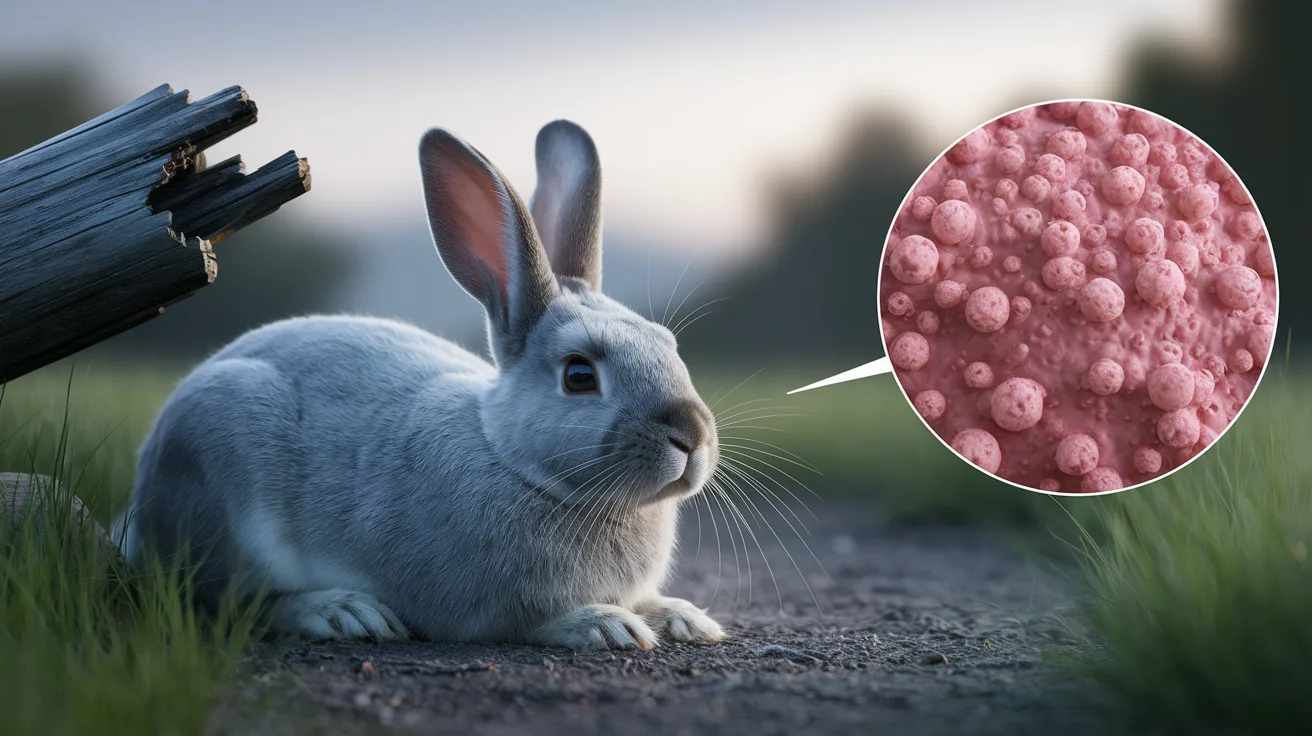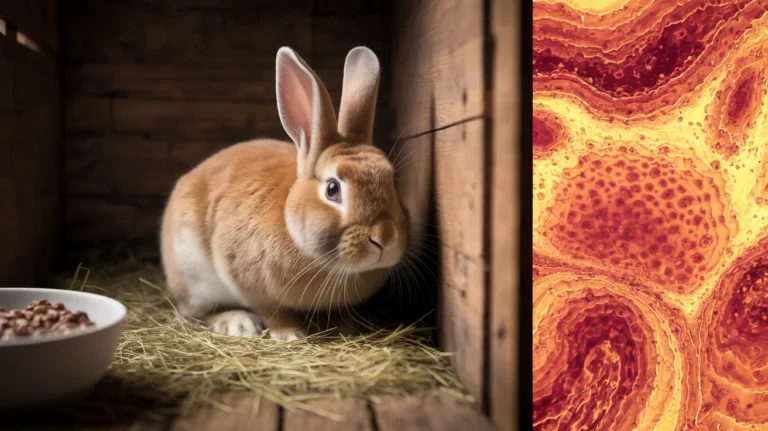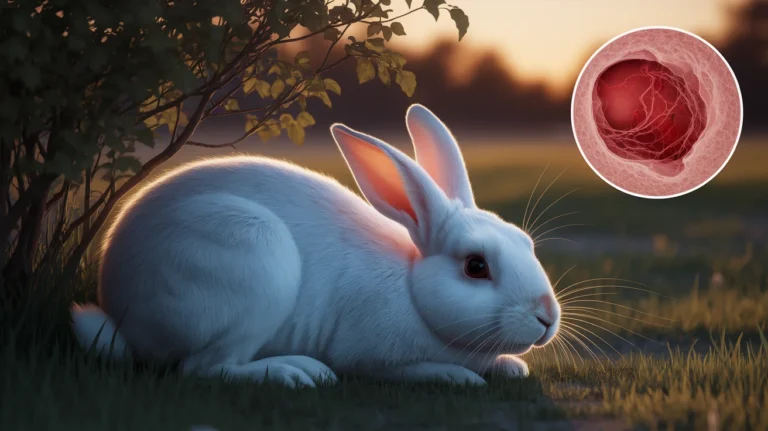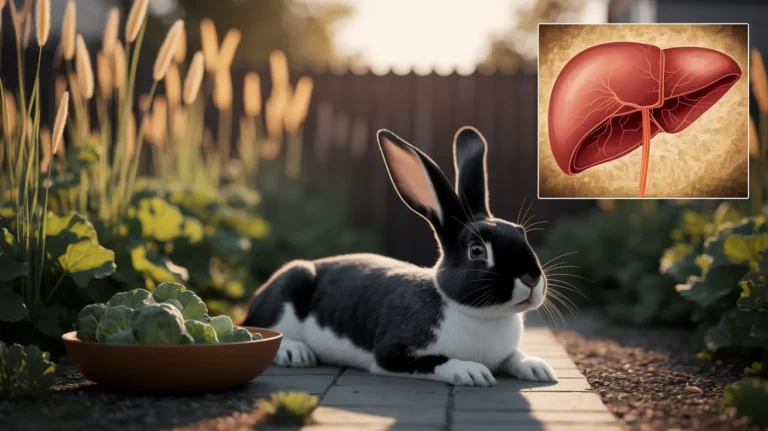Discover the 4 most common sources of rabbit poisoning and learn practical strategies to create a safe environment for your pet rabbit with this comprehensive guide.
Rabbits make wonderful companions with their gentle nature and adorable personalities, but their curious habits and sensitive digestive systems make them particularly vulnerable to poisoning. As responsible rabbit owners, understanding the common toxins that threaten our furry friends is crucial for prevention and prompt response in emergencies. Rabbit poisoning can occur through ingestion of toxic plants, household chemicals, contaminated food, or medications not meant for lagomorphs. This comprehensive guide explores the four most common sources of rabbit poisoning and provides detailed strategies to create a safe environment for your beloved pet. Whether you’re a new rabbit owner or an experienced caretaker, this information will help you protect your rabbit from potentially life-threatening toxins.
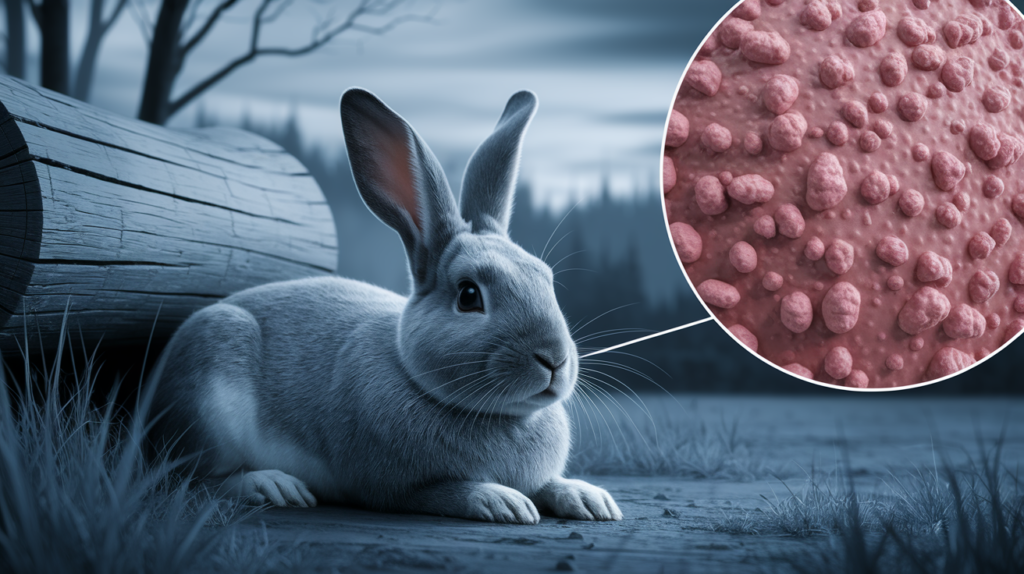
Table of Contents
Understanding Rabbit Poisoning
What Makes Rabbits Susceptible to Poisoning?
Rabbits have several physiological characteristics that increase their vulnerability to toxic substances:
- Sensitive Digestive Systems: Rabbits have specialized digestive systems designed primarily for processing fibrous plant materials. Their gastrointestinal tracts are highly sensitive to changes, making them susceptible to toxins that other pets might tolerate.
- Inability to Vomit: Unlike cats and dogs, rabbits cannot vomit to expel toxic substances they’ve ingested. Once a toxin enters their system, it will be processed through their body unless medical intervention occurs.
- Grooming Habits: Rabbits are fastidious groomers, spending significant time cleaning their fur. This means any substance on their coat may be ingested during grooming, increasing poisoning risks from environmental toxins.
- Curious Nature: Rabbits explore their environment through nibbling and tasting, which can lead to accidental ingestion of harmful substances.
- Small Body Size: With their relatively small body mass, even small amounts of toxins can have severe or fatal effects on rabbits.
Signs and Symptoms of Rabbit Poisoning
Recognizing the symptoms of poisoning early can save your rabbit’s life. Common indicators include:
- Gastrointestinal Distress:
- Diarrhea or unusual stool
- Reduced appetite or complete refusal to eat
- Bloating or abdominal discomfort
- Unusual posture (hunched back)
- Behavioral Changes:
- Lethargy or weakness
- Unusual aggression
- Disorientation or confusion
- Depression or lack of interest in surroundings
- Physical Symptoms:
- Difficulty breathing
- Excessive drooling
- Tremors or seizures
- Unusual eye discharge or tearing
- Pale or blue-tinged gums
- Excessive thirst
- Elevated or reduced body temperature
- Severe Symptoms (indicating emergency):
- Collapse
- Unconsciousness
- Severe tremors or seizures
- Complete lack of response to stimuli
According to a 2023 survey by the American Rabbit Breeders Association, approximately 28% of rabbit owners have experienced at least one poisoning scare with their pets, highlighting the prevalence of this concern among rabbit caretakers.
Common Toxin 1: Toxic Plants
Dangerous Houseplants for Rabbits
Many common houseplants can cause severe rabbit poisoning. The most dangerous include:
- Lilies (all varieties):
- Extremely toxic to rabbits
- Can cause kidney failure, even in small amounts
- Symptoms appear within 6-12 hours of ingestion
- Even pollen from lilies can be harmful if groomed off fur
- Philodendron and Pothos:
- Contain insoluble calcium oxalate crystals
- Cause immediate oral irritation and swelling
- Can lead to difficulty breathing and swallowing
- May cause kidney damage in severe cases
- Azaleas and Rhododendrons:
- Contain grayanotoxins
- Cause vomiting, diarrhea, and cardiac issues
- As little as 0.2% of body weight can be lethal
- Symptoms typically appear within 6 hours of ingestion
- Daffodils and Tulips:
- Bulbs are especially toxic
- Contain lycorine and other alkaloids
- Cause severe gastrointestinal issues
- May lead to cardiac arrhythmias and respiratory depression
Toxic Garden Plants and Weeds
Outdoor rabbits or those with access to gardens face additional plant toxin risks:
- Foxglove (Digitalis):
- Contains cardiac glycosides
- Causes heart rhythm abnormalities
- Fatal in small amounts
- All parts are toxic, but leaves are especially dangerous
- Nightshade Family (tomato and potato plants):
- Green parts contain solanine
- Cause neurological and gastrointestinal symptoms
- Can be fatal in sufficient quantities
- Tomato and potato fruits are generally safe in moderation, but plants and leaves are toxic
- Buttercups:
- Contain ranunculin
- Cause blistering of mouth and digestive tract
- Lead to bloody diarrhea and excessive salivation
- Toxicity decreases when dried but remains present
- Hemlock:
- Contains coniine and other piperidine alkaloids
- Resembles parsley or wild carrot
- Causes paralysis and respiratory failure
- Small amounts can be lethal within hours
Prevention Strategies for Plant Poisoning
To protect your rabbit from toxic plants:
- Conduct a Plant Inventory: Identify all plants in your home and garden, removing toxic varieties or keeping them in inaccessible areas.
- Create Safe Exercise Areas: Ensure outdoor run areas are free from toxic plants and treated lawns.
- Provide Safe Alternatives: Offer rabbit-safe plants like basil, cilantro, dill, mint, and rabbit-safe grasses to satisfy natural browsing instincts.
- Regular Monitoring: Check garden areas regularly for new growth of toxic weeds.
- Consult With Experts: When unsure about a plant’s safety, consult with a veterinarian or rabbit specialist before allowing access.
Common Toxin 2: Household Chemicals
Cleaning Products and Rabbit Poisoning
Household cleaning products present significant poisoning risks through direct ingestion, absorption through paws, or inhalation:
- Surface Cleaners:
- Ammonia-based cleaners can cause respiratory distress
- Bleach products can burn mucous membranes
- Residues on floors may transfer to fur during normal rabbit activity
- Fumes can cause respiratory irritation even without direct contact
- Disinfectants:
- Phenol-based products (like Pine-Sol) are particularly toxic
- Can cause liver failure even in small amounts
- Remain dangerous even after surfaces appear dry
- May be absorbed through foot pads during normal movement
- Air Fresheners and Plugins:
- Essential oils can be toxic to rabbits
- Synthetic fragrances may cause respiratory distress
- Liquid from plug-in devices may drip and be ingested
- Aerosols settle on fur and may be ingested during grooming
- Laundry Products:
- Detergent residue on bedding can cause skin irritation
- Fabric softener sheets contain cationic detergents toxic to rabbits
- Dryer sheet residue may transfer to rabbit bedding
- Pods/capsules are particularly dangerous if punctured by curious teeth
Home Maintenance Products
Beyond cleaning supplies, many home maintenance products pose serious risks:
- Paints and Solvents:
- Contain volatile organic compounds (VOCs)
- Cause neurological symptoms and liver damage
- Fumes can affect rabbits even in separate rooms
- Water-based products are safer but still require caution
- Pest Control Products:
- Rodenticides are particularly dangerous (similar mammals)
- Insecticides can cause neurological symptoms
- Residues remain active for days or weeks
- Secondary poisoning possible from affected insects
- Automotive Fluids:
- Antifreeze (ethylene glycol) is sweet-tasting but lethal
- As little as 1 teaspoon can be fatal to a rabbit
- Causes kidney failure within 24-72 hours
- Often has delayed symptoms until damage is severe
- Adhesives and Glues:
- Contain toxic solvents that cause respiratory distress
- May stick to fur or paws, leading to ingestion during grooming
- Super glue emits cyanoacrylate fumes harmful to sensitive lungs
- Expanding glues can cause gastrointestinal obstruction
Rabbit-Safe Cleaning Alternatives
To maintain a clean yet safe environment for your rabbit:
- Vinegar Solutions: Diluted white vinegar (1:1 with water) serves as an effective, rabbit-safe disinfectant for most surfaces.
- Baking Soda: Works for scrubbing and deodorizing without harmful chemicals.
- Steam Cleaning: High-temperature steam sanitizes without chemicals.
- Hydrogen Peroxide: 3% solution works as a disinfectant that breaks down into harmless water and oxygen.
- Commercial Pet-Safe Products: Look for products specifically labeled as safe for small animals or rabbits.
According to veterinary toxicology reports, approximately 22% of rabbit poisoning cases are attributed to household chemicals, making awareness and prevention crucial.
Common Toxin 3: Toxic Foods
Foods That Cause Rabbit Poisoning
While rabbits thrive on a diet of hay, limited pellets, and selected vegetables, many common foods can cause serious health issues or poisoning:
- High-Sugar Fruits and Treats:
- Cause dangerous disruptions to gut flora
- Lead to enterotoxemia (fatal intestinal overgrowth)
- Trigger potentially fatal GI stasis
- Examples: chocolate, candy, sugary cereals, large amounts of fruit
- Allium Family:
- Includes onions, garlic, shallots, leeks, and chives
- Contain thiosulfates that damage red blood cells
- Cause hemolytic anemia even in small amounts
- Effects may accumulate with repeated exposure
- Processed Human Foods:
- High in salt, fat, and preservatives
- Cause liver damage and obesity
- Disrupt critical gut bacteria balance
- Examples: bread, crackers, chips, cookies, processed meats
- Avocado:
- Contains persin, toxic to many animals including rabbits
- Affects cardiovascular system
- All parts are toxic (fruit, pit, leaves, bark)
- Symptoms include difficulty breathing, fluid accumulation, and heart damage
Unexpected Food Dangers
Some less obvious food items that can cause rabbit poisoning include:
- Iceberg Lettuce:
- Contains lactucarium, a mild sedative
- Provides minimal nutrition while disrupting digestion
- Can cause diarrhea and dehydration
- Often mistakenly given as a staple green
- Seeds and Pits:
- Many fruit seeds contain cyanide compounds
- Cherry, apple, peach, and apricot pits are particularly dangerous
- Can cause respiratory failure and death
- Risk of choking and intestinal obstruction
- Beans and Legumes (raw):
- Contain phytohemagglutinin
- Cause severe digestive upset and potential hemolysis
- Includes kidney beans, lima beans, soybeans
- Cooking destroys the toxin but cooked beans are still not appropriate for rabbits
- Yogurt Drops and Commercial Treats:
- Often marketed specifically for rabbits despite being dangerous
- Contain dairy, sugar, and preservatives
- Disrupt digestive flora
- Contribute to obesity and dental problems
Creating a Safe Feeding Routine
To ensure your rabbit’s diet remains safe and healthy:
- Follow the 85-10-5 Rule: 85% hay, 10% leafy greens, 5% pellets.
- Introduce New Foods Gradually: Add one new vegetable at a time in small amounts.
- Research Before Feeding: Always verify a food’s safety before offering it to your rabbit.
- Monitor After New Foods: Watch for digestive changes after introducing new items.
- Maintain Fresh Water: Ensure clean, fresh water is always available to help process foods and flush toxins.
A 2023 study in the Journal of Veterinary Medicine found that dietary-related poisoning accounts for approximately 31% of rabbit emergency visits, highlighting the importance of dietary vigilance.
Common Toxin 4: Medications and Supplements
Human Medications Toxic to Rabbits
Human medications pose significant poisoning risks to rabbits due to their different metabolism and physiology:
- Pain Relievers:
- NSAIDs (ibuprofen, naproxen) cause GI perforation and kidney failure
- Acetaminophen (Tylenol) causes liver failure and methemoglobinemia
- Even topical pain creams can be toxic if groomed off
- A single ibuprofen tablet can be fatal to a rabbit
- Antibiotics:
- Certain antibiotics (amoxicillin, clindamycin) disrupt crucial gut flora
- Cause potentially fatal dysbiosis and enterotoxemia
- Effects can appear within 24 hours of administration
- Can lead to death even days after administration stops
- Antifungals:
- Many oral antifungals cause liver damage in rabbits
- Topical creams may be groomed off and ingested
- Effects may not be apparent until significant damage occurs
- Include both prescription and over-the-counter preparations
- Cold and Allergy Medications:
- Decongestants cause cardiac issues in rabbits
- Antihistamines may be safe in proper doses but are often combined with unsafe ingredients
- Cough suppressants affect respiratory function
- Even “natural” cold remedies often contain unsuitable herbs
Dangerous Supplements and Remedies
Even well-intentioned health products can cause rabbit poisoning:
- Herbal Supplements:
- Many herbs toxic to rabbits (e.g., comfrey, foxglove, St. John’s wort)
- Effects range from mild digestive upset to organ failure
- Concentration in supplements much higher than in plants
- Even “pet-safe” herbal products may not be tested on rabbits
- Vitamins and Minerals:
- Fat-soluble vitamins (A, D, E) can accumulate to toxic levels
- Excess calcium contributes to urinary stones and kidney damage
- Multivitamins formulated for other species have improper ratios
- Healthy rabbits on proper diets rarely need supplementation
- Essential Oils:
- Highly concentrated and rapidly absorbed
- Cause liver damage, neurological issues
- Dangerous through inhalation, absorption, and ingestion
- Even diffused oils can settle on fur and be ingested during grooming
- Homeopathic Remedies:
- May contain alcohol bases toxic to rabbits
- Sometimes include dangerous herbs or substances
- Delay proper veterinary treatment
- Dosing information rarely available for rabbits
Safe Medication Practices
To protect your rabbit from medication-related poisoning:
- Never Self-Prescribe: Always consult an exotic veterinarian experienced with rabbits before administering any medication.
- Proper Storage: Store all medications in cabinets inaccessible to rabbits.
- Check All Ingredients: For any prescribed medication, verify all inactive ingredients are safe for rabbits.
- Follow Exact Dosing: Use precision measuring tools for prescribed medications; rabbit doses are often tiny.
- Separate Administration Area: Give medications in an area separate from the rabbit’s normal environment to prevent accidental drug residue exposure.
Research from the Exotic Animal Veterinary Association indicates that approximately 18% of rabbit poisoning cases involve inappropriate medication administration, emphasizing the need for caution with all medicinal products.
Creating a Rabbit-Safe Environment
Rabbit-Proofing Your Home
Creating a comprehensive rabbit-safe environment involves:
- Space Assessment:
- Crawl at rabbit level to identify hazards
- Check under furniture for accessible cords or toxic materials
- Identify escape routes and potential hiding spots
- Note areas where cleaning products or chemicals are stored
- Cord Protection:
- Cover all electrical cords with split plastic tubing
- Raise cords above rabbit reach when possible
- Unplug and store unused cords
- Consider cord-free alternatives for frequently chewed items
- Furniture Protection:
- Block access to undersides of furniture with NIC grids or pet barriers
- Apply bitter apple spray to discourage chewing (test in small area first)
- Provide alternative chewing options like untreated wood toys
- Remove or securely cover furniture with toxic finishes or materials
- Restricted Access:
- Install baby gates or exercise pens around dangerous areas
- Use cabinet locks for storage areas containing chemicals
- Create designated “rabbit rooms” that are fully rabbit-proofed
- Consider door sweeps to prevent access under doors
Emergency Preparedness for Rabbit Poisoning
Being prepared for poisoning emergencies can save your rabbit’s life:
- Veterinary Contacts:
- Keep contact information for rabbit-savvy veterinarians readily available
- Identify 24-hour emergency clinics that treat rabbits
- Save poison control hotline numbers (Animal Poison Control: 888-426-4435)
- Join online rabbit communities for emergency advice
- Emergency Kit:
- Activated charcoal (only use if directed by a veterinarian)
- Clean towels for wrapping and transport
- Syringe for water administration
- Critical care formula for force feeding
- Travel carrier ready for quick transport
- Documentation:
- Keep a list of potential toxins your rabbit has been exposed to
- Document timing of exposure and symptoms
- Photograph or save samples of suspected toxins
- Maintain current weight records for accurate dosing calculations
- Transport Plan:
- Identify fastest route to emergency veterinary care
- Have a designated driver if possible
- Keep funds or credit available for emergency treatment
- Practice carrier training to reduce transportation stress
Ongoing Monitoring and Adjustment
Creating a truly safe environment requires continuous vigilance:
- Regular Safety Audits: Conduct monthly checks for new hazards.
- Seasonal Assessments: Be aware of seasonal changes bringing new risks (holiday plants, spring cleaning products).
- New Product Verification: Research any new product (plants, cleaners, toys) before introducing it to your rabbit’s environment.
- Visitor Education: Inform guests about rabbit safety to prevent accidental poisoning risks from purses, medications, or gifts.
- Stay Informed: Follow rabbit-specific resources and forums to learn about newly identified risks.
According to the House Rabbit Society, implementing comprehensive rabbit-proofing measures reduces poisoning incidents by approximately 83%, demonstrating the effectiveness of preventive approaches.
FAQs About Rabbit Poisoning
What should I do if I suspect my rabbit has been poisoned?
If you suspect poisoning, act immediately. Contact a rabbit-savvy veterinarian or emergency exotic pet clinic. Do not induce vomiting (rabbits cannot vomit safely). While waiting for professional help, remove any remaining toxin from the environment, document what and how much your rabbit may have consumed, and when it happened. Keep your rabbit warm and quiet during transport. Never “wait and see” with suspected poisoning, as early intervention dramatically improves survival rates.
How can I tell if a plant is safe for my rabbit?
Always verify any plant’s safety through multiple reliable sources before introducing it to your rabbit. The House Rabbit Society, Rabbit Welfare Association, and experienced exotic veterinarians maintain lists of safe and toxic plants. When in doubt, assume a plant is unsafe until proven otherwise. Even “rabbit-safe” plants should be introduced gradually and in moderation, as individual rabbits may have sensitivities to otherwise safe plants.
Are there any safe human foods I can share with my rabbit?
While the majority of a rabbit’s diet should consist of unlimited high-quality hay, limited pellets, and specific vegetables, some human foods can be offered as occasional treats. Safe options include small amounts of apple (no seeds), strawberry tops, blueberries, cilantro, basil, mint, and dandelion greens. Always introduce new foods gradually, one at a time, in very small amounts (teaspoon size) to monitor for digestive upset.
How do I safely clean my rabbit’s habitat without using toxic chemicals?
For routine cleaning, a solution of equal parts white vinegar and water works effectively for most surfaces. For deeper disinfection, 3% hydrogen peroxide is rabbit-safe once dry. Steam cleaning provides chemical-free sanitization for flooring and hard surfaces. Always ensure that enclosures are completely dry before reintroducing your rabbit. Avoid pine or cedar shavings as bedding, as the phenols they release can cause respiratory and liver damage.
What should be included in a rabbit first aid kit for poisoning emergencies?
A rabbit emergency kit should include contact information for rabbit-savvy veterinarians, including 24-hour emergency services; activated charcoal (use only if directed by a veterinarian); a feeding syringe for administering fluids; Critical Care or similar supportive nutrition formula; clean towels for bundling; a digital thermometer for monitoring body temperature; a heat source like a hot water bottle; and a secure carrier for transport. Additionally, keep a record of your rabbit’s normal weight for medication dosing.
Can rabbits build tolerance to toxic substances over time?
No, rabbits do not develop tolerance to truly toxic substances. Repeated exposure to toxins typically results in cumulative damage to organs like the liver and kidneys, potentially leading to chronic health issues or sudden failure when a threshold is reached. What may appear as tolerance can actually be subclinical damage accumulating over time. Always prevent exposure to known toxins, regardless of whether your rabbit has previously encountered the substance without obvious symptoms.
How can I rabbit-proof my garden to prevent plant poisoning?
Create dedicated rabbit exercise areas using secure fencing that extends at least 1 foot underground to prevent digging. Within these areas, remove all toxic plants and verify that all remaining vegetation is rabbit-safe. Regularly inspect the area for toxic weeds that may sprout. Consider raising edible plants in elevated beds beyond rabbit reach while providing safe alternatives like rabbit-friendly herb gardens at ground level. Never use chemical pesticides, herbicides, or fertilizers in areas accessible to rabbits.
Recommended Pet Products on Amazon
Rabbit Care Essentials
- Living World XL Rabbit Habitat – Spacious enclosure with secure latching system to prevent escape and access to hazards
- Oxbow Animal Health Organic Meadow Hay – Premium timothy hay free from pesticides and chemicals that could cause rabbit poisoning
- Kaytee Chew-Proof Water Bottle – Prevents leaking that could dampen habitat and promote toxic mold growth
- Pet Proofing Cord Protector Tubes – Heavy-duty split tubing to prevent chewing of electrical cords, a common poisoning hazard
Ensuring Long-Term Rabbit Safety
Creating and maintaining a safe environment for your rabbit requires ongoing vigilance and education. By understanding the four major sources of rabbit poisoning—toxic plants, household chemicals, dangerous foods, and inappropriate medications—you can significantly reduce the risk to your furry companion.
Remember that prevention is always preferable to treatment, especially considering rabbits’ delicate systems and the often rapid progression of poisoning symptoms. Implement a comprehensive rabbit-proofing strategy for your home, maintain a strict policy of researching anything new before introducing it to your rabbit’s environment, and establish relationships with exotic veterinarians experienced in rabbit care before emergencies arise.
For more expert advice on rabbit care, health concerns, and environmental enrichment, visit BlithePet for regularly updated resources specifically tailored to rabbit owners.
Have you experienced a rabbit poisoning scare? Share your experience in the comments below to help educate and prepare other rabbit owners for these potentially life-threatening situations.

